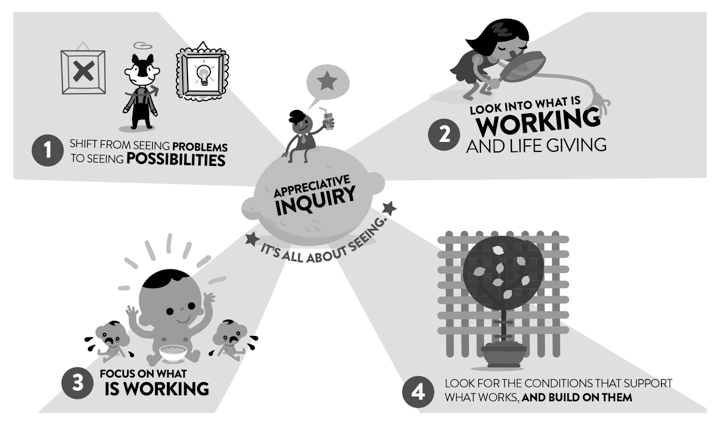Appreciative Inquiry
Episode #2 of the course 10 tools for change by Kate Sutherland
Welcome back!
Today, we’ll glean nuggets from Appreciative Inquiry, an organizational development approach pioneered by David Cooperrider in the ‘80s.
Here’s the key takeaway: Focus on possibilities, not problems!
Most of us and most groups tend to focus on what’s wrong. We relish cataloging what’s not working and how things might get worse.
The same is true for the voices in our heads: “You didn’t do that very well.” “Don’t be so stupid.”
All this negative focus is debilitating.
The bigger the problems we face personally and in our teams, the more important it is that we shift our focus to seeing what is right.
Too Positive?
But first, are you concerned that a “positive” focus can be used to gloss over issues?
You should be! This absolutely happens, and yet, we deal better with real problems and challenges when we come at them appreciatively.
I hope you’ll try it. Here’s how.
Appreciative Lens
Appreciative Inquiry focuses on the “positive core”—the factors and characteristics present when an individual, group, organization, or community is at its best.
By asking, “What do you value?” or, “What works well here?”—even in the most toxic of communities, workplaces, or teams—the conversation changes in profound ways.
An appreciative focus surfaces people’s wisdom and goodwill. In place of negativity, despair, and overwhelm, people’s latent decency, wisdom, and engagement are unleashed. Authentic appreciation shifts the energy. For both individuals and groups, that energy shift is like wind in the sails of positive change.
Inquiry
Now that you’re energized by having discovered something to appreciate, the next questions are, “What conditions supported this wonderful thing to happen? How can we have more of what’s working? Can we translate what’s working here to help us over there?”
Inquiry helps us understand how the “bright spots” came to be and points the way to having many more.
Here’s a story to illustrate.
Bright Spots
Appreciative Inquiry allowed a foreign-aid worker to improve child nutrition in Vietnam in a mere six months and with zero budget for food. Instead of focusing on the malnourished children, his team located families where babies had above average weight, a direct indicator of better nourishment.
The researchers culled out those families who had higher than average incomes, to leave only families with babies doing better than average given their family circumstances. Then researchers investigated what these families were doing differently.
It turned out that the differences were simple and highly replicable: In place of two to three larger meals, the bright spot families were feeding the same amount per day in four to five smaller portions, and supplementing their children’s diets with readily available weeds (greens) and small shrimp wild-harvested from the rice paddies.
By organizing meetings where the bright spot mothers shared with other mothers the specifics of what they were doing, the innovations spread, significantly and quickly improving the nutrition of local children. (See Switch: How to change when change is hard by Chip Heath and Dan Heath.)

At the Personal Level
Over time, working appreciatively becomes a way of being. We change our default setting from focusing on what’s wrong to seeing what’s right. The more we do this in our personal lives, the better we can respond appreciatively in our relationships, groups, and organizations.
In our personal lives, an appreciative focus can include how we see:
• ourselves
• our parents and siblings
• our children
• our neighbors
• our circumstances
• our potential
Take a moment right now to reflect appreciatively on an aspect of your personal life. Pick something that’s challenging or difficult, and let yourself “rip” with complaining, blaming, or negativity.
Now choose to shift from seeing problems to seeing possibilities. Do you notice a shift in your energy and outlook? For example, I recently shifted feeling overwhelmed by my workload into feeling excited by and grateful for emerging possibilities and all that I’m learning.
In Our Teams
Similarly, in the group and organizational aspects of our lives, bringing an appreciative lens has a profound impact. Consider framing issues appreciatively when:
• defining the agenda for a meeting
• conducting a performance review
• setting strategic goals
• building capacity in teams and organizations
• creating collaborations and partnerships
• dealing with crises
The list of potential applications is endless because focusing on what is life-giving is a stance that we can take toward all of life. It’s a way of being as much as it’s a way of doing. As such, we can bring an appreciative lens to virtually everything!
Tomorrow, we’ll explore Chaordic Design—distilled wisdom from inquiring appreciatively into human organizations functioning at their best. You’ll learn six steps for designing everything from a meeting to a global initiative.
See you then!
Kate
Recommended book
Appreciative Inquiry: Collaborating for Change by David L. Cooperrider, and Diana Whitney
Share with friends

